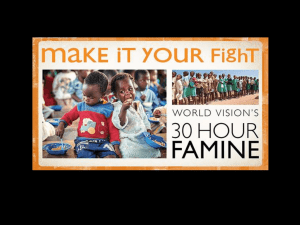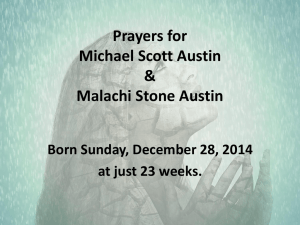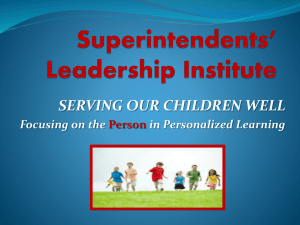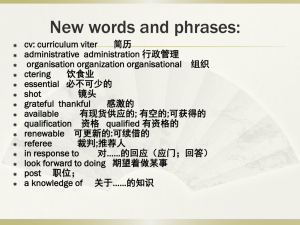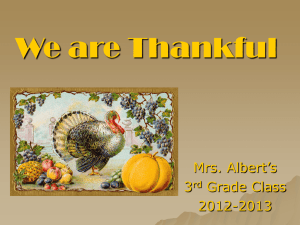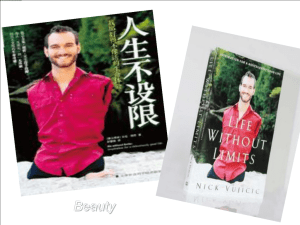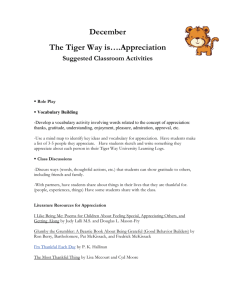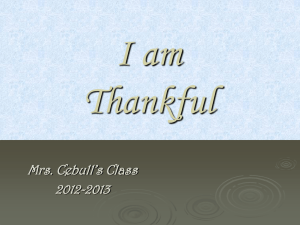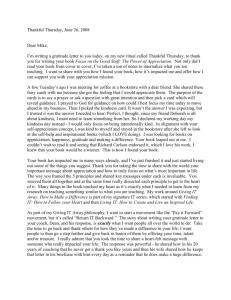File
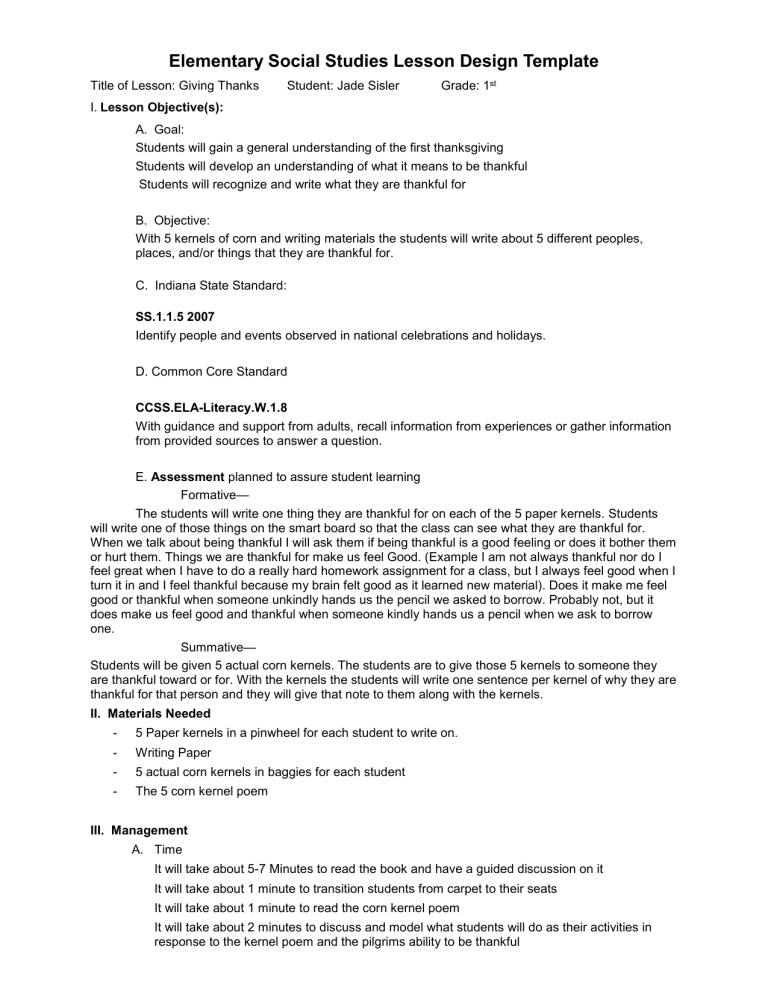
Elementary Social Studies Lesson Design Template
Title of Lesson: Giving Thanks Student: Jade Sisler Grade: 1 st
I.
Lesson Objective(s):
A. Goal:
Students will gain a general understanding of the first thanksgiving
Students will develop an understanding of what it means to be thankful
Students will recognize and write what they are thankful for
B. Objective:
With 5 kernels of corn and writing materials the students will write about 5 different peoples, places, and/or things that they are thankful for.
C. Indiana State Standard:
SS.1.1.5 2007
Identify people and events observed in national celebrations and holidays.
D. Common Core Standard
CCSS.ELA-Literacy.W.1.8
With guidance and support from adults, recall information from experiences or gather information from provided sources to answer a question.
E. Assessment planned to assure student learning
Formative —
The students will write one thing they are thankful for on each of the 5 paper kernels. Students will write one of those things on the smart board so that the class can see what they are thankful for.
When we talk about being thankful I will ask them if being thankful is a good feeling or does it bother them or hurt them. Things we are thankful for make us feel Good. (Example I am not always thankful nor do I feel great when I have to do a really hard homework assignment for a class, but I always feel good when I turn it in and I feel thankful because my brain felt good as it learned new material). Does it make me feel good or thankful when someone unkindly hands us the pencil we asked to borrow. Probably not, but it does make us feel good and thankful when someone kindly hands us a pencil when we ask to borrow one.
Summative —
Students will be given 5 actual corn kernels. The students are to give those 5 kernels to someone they are thankful toward or for. With the kernels the students will write one sentence per kernel of why they are thankful for that person and they will give that note to them along with the kernels.
II. Materials Needed
- 5 Paper kernels in a pinwheel for each student to write on.
- Writing Paper
- 5 actual corn kernels in baggies for each student
- The 5 corn kernel poem
III. Management
A. Time
It will take about 5-7 Minutes to read the book and have a guided discussion on it
It will take about 1 minute to transition students from carpet to their seats
It will take about 1 minute to read the corn kernel poem
It will take about 2 minutes to discuss and model what students will do as their activities in response to the kernel poem and the pilgrims ability to be thankful
It will take about 3 minutes for students to write on the kernels
It will take about 5 minutes for students to write about who they are thankful for.
Students will take 1 minute to share in groups what they wrote
It will take 3 minutes for closure
B. Behavior
Students will be prompted by me when to think internally and when to raise their hand to think out loud. Students will follow classroom procedure on the carpet, which is to sit still on their sticker and remain quiet unless asked to respond to a question. Students will not transition off of carpet until asked to and they will follow classroom procedure to desks, quickly and quietly.
Students will listen to instruction and will follow classroom procedures as they write and ask questions. Students will share in groups of 2-3 with a 1 vector voice.
C. Adaptations:
- ELL students: I will provide a copy of the kernel poem in their language to share with their parents. I will be sure to speak clearly and slowly so that all students, not just the ELL students can understand me.
- Students with special needs: o For students with sight problems I can magnify the words if the book I am reading to students by putting it under the projector light. I can also write on the board in words large enough for them to read. o For students with hearing problems I will be sure to speak clearly and keep the noise level of the class down to a minimum and have any student who speaks with permission to stand in front of the class. o For students who struggle with writing or language comprehension I will walk around the room to assist them as I observe other students and I will write some key words they may end up using on the board.
- For students who have a difficult time following class procedures, the consequences of not following classroom procedures the way they know they ought to will be followed (marking their name on the board or sitting in time out.)
IV. Lesson Presentation: (description of procedure)
A. Introduction
Anticipatory set: “Close your eyes. I am going to take you on a journey back in time to the first thanksgiving. You are sitting at a long table with many people around you. All of them are your friends and family members. There are also many Indians from the local tribe joining you who helped your settlement to grow a lot of the crops on. On the table in front of you is a buffet style meal with anything you could possibly imagine to eat. But beside your plate are 5 kernels of corn. You don’t like kernel corns because for weeks the only food available to eat everyday was kernels of corn, 5 kernels of corn exactly. You notice that around the table people are taking turns standing and saying something about each kernel of corn. Soon it will be your turn to speak.”
B. Body/Input/Output (step by step)
After telling this little story to get students to imagine the first thanksgiving you will tell them that what they saw at the table were people who were thankful because they had been given food, something they had very little of. The pilgrims, despite not having a lot of food before, were going around and giving thanks for what they had when they didn’t have food and the people they were thankful for. Each pilgrim would use a kernel for corn for each thing they were. This became so well-known that someone wrote a poem about it.
“I have a poem called the 5 kernels of corn that talks about what the pilgrims used to help them remain thankful through the hard winter. Let us go back to our desks and I will read it to you, you will see that there are 5 kernels of corn in a plastic baggie on your desk, I ask that you do not touch them but you may look at them as I read the poem to you.”
After reading the poem to them I will talk to them about the 5 Kernels of corn the Pilgrims used to remind them to be thankful every thanksgiving. I will ask the students:
“What does it mean to be thankful for something?”
“Each kernel of corn represented something or someone the pilgrims were thankful for during every
thanksgiving. There would be 5 kernels by everyone’s plates and as they ate they would go around the table and each pilgrim would share the 5 things or people the pilgrims were thankful for”
“See the 5 paper kernels in front of you? You are going to share with me the 5 things or people you are thankful for by writing in 12 words on those kernels.”
I will model for them and write the 5 things I am thankful for and talk about them.
I will write the agenda on the board so they can follow it.
“When you are finished with the kernels you are going to take a piece of writing paper and title it with the name of a person you are thankful for. For each kernel of corn in the baggie you will write one sentence about why you are thankful for them (one sentence per kernel) when you are finished I will staple your baggie of kernels to your paper and you will give it to the person you wrote about”
I will also model the above part, however I will not write all the sentences just one or two to demonstrate.
As the students write I will walk around the room and observe their writing and thought processes. I will be able to keep the students on task who tend to wonder and are easily distracted and help those students that process things slower to catch up.
As the students finish I will put them in pairs and have them share what they are thankful for.
When students are finished with the assignments I will tie everything together and say that
“The pilgrims were thankful when times were hard, how can the 5 kernels remind up about the importance of being thankful toward others and toward the good things we have when times are hard?
”
“We can be thankful for people, places, and events and remember those good things that have happened so when we face hard times it becomes easier to be thankful”
“The pilgrims faced many hard times, but they remembered the good thing and were thankful when times were hard”
D. Conclusion/closure
(this will occur at the carpet)
When students are finished with the assignments I will tie everything together and say that
“The pilgrims were thankful when times were hard, how can the 5 kernels remind up about the importance of being thankful toward others and toward the good things we have when things do not always go well ?”
“We can be thankful for people, places, and events and remember those good things that have happened so when we face hard times it becomes easier to be thankful”
“The pilgrims faced many hard times, but they remembered the good thing and were thankful when times were hard”
“Thanksgiving is a time to give thanks for what we do have, not wishing for what we don’t. It is called thanksgiving so we are reminded to be thankful for what we have been given”
I will have each student share with a partner who they are thankful for. I will listen to hear what is said.
“What are some things we can be thankful for in the classroom? For example I am thankful for windows, even though I can’t see out of them. We still get light from them.
Share with a partner what they are thankful for
You can find ways and things to be thankful for in the class, in the school, on the bus, at home, and wherever you go. Did we find ways to be thankful today? Can we find something to be thankful for everyday?
D. Independent Practice
Students will give their writing sheet of 5 sentences about who they are thankful for to the person they are thankful for. They will go home and ask someone on their family what they are thankful for and write it down.
E. Elements of Differentiation –
For students who may not get all of their writing finished they will have a chance during recess to finish it. They will also be able to take it home and finish it as well as long as they can tell you they gave it to the intended person they wrote about by the next day.
For students who are more musical or rhythmic they may write in a poetical format.
Students who are mathematical may write in lists.
Students will be given a chance to draw about what they wrote if there is time.
Students will be given the time to share with others to enrich their interpersonal and intrapersonal relationships.
Students who are kinesthetic will be invigorated because we will not stay in the same spot for activities.
Students who are verbal or auditory will be able to talk about what they wrote and listen to what others wrote.
V.
University Student’s Analysis of Lesson
How many students achieved the objective for today? For those who did not, why not?
What were my strengths, and opportunities for growth?
How would I alter this lesson?
How would I pace it differently?
Were all students actively participating? If not, Why not?
How could I better address the needs of diverse students?
What adjustments did I make to reach varied learning styles and ability levels?
(Blooms’s Taxonomy, Gardner’s Multiple Intelligences)
What strategies have I included that are designed to encourage elementary students’ development of critical thinking and problem solving?
